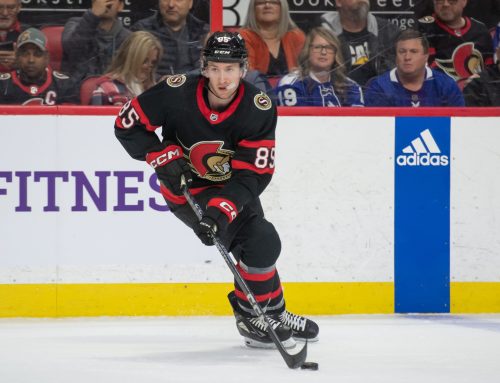Ramblings: Pasta Problems, Draft Strategies (Sept 13)
Ian Gooding
2017-09-12

Pasta Problems, Draft Strategies with spreadsheets in mind, plus more…
In my auction league (and in many other leagues), the one position that has been recognized as being relatively thin is right wing. Mid-tier right wings have been selling at higher prices than higher-tier centers and even left wings. Turned off by some of the prices of right wings, I’ve decided to go thin at that position this season.
One of the right wingers that I’m hoping to lean on heavily this season is David Pastrnak. And now there’s news that multiple KHL teams have posted current offers for the unsigned Bruins’ sniper. No doubt this is a bit of a nerve-racking time for his keeper owners. His single-season draft ranking may also start to fall if he’s a no-show for the start of training camp.
The Bruins currently have about $10 million in cap space, but Pastrnak would eat a considerable portion of that (anywhere between $6 – $8 million). Assuming they bring in a few more non-roster players as they need to (particularly forwards), they will probably be up against the cap. According to Cap Friendly, the Bruins have only 11 forwards signed to the current roster, which explains to some degree why they don’t just sign Pastrnak today to the $8 million that he wants. That bargaining zone amount of $1-2 million could be the difference between whether a young forward like, say, Anders Bjork makes the team.
This is a team that has had cap issues because of success in the last half-dozen years, but it has also let young stars like Tyler Seguin and Dougie Hamilton slip away. So there’s always that slim chance that the Bruins could flub this up and Pasta spends the season in the K. That would be a major blow to the Bruins' playoff chances if that were to happen.
This KHL talk could be a negotiating tactic, though. So if you’re a Pastrnak owner, don’t panic with a desperation deal. Or in my case, don’t place an exorbitantly high bid for Richard Panik. It’s entirely possible that this gets settled tomorrow and all is normal with the state of the world again. Have a contingency plan in mind, though, in case the worst happens.
*
I’m going to take a slightly different turn in today’s Ramblings. Instead of writing about a few players as I normally do, I’m going to cover a few draft strategies that I’ve been applying as I organize for drafts.
This is by no means a complete list of draft strategies. Rather, these are some points to bear in mind before and during your draft. As much as they may build on normal draft strategies, they may also deviate from normal draft strategies in some way.
Much of what I am about to say ties back to one basic rule of drafts: Know your scoring system.
Use ranking lists, but understand their limitations
Rankings are great. They can do a lot of work for you, particularly if you haven’t prepared for your draft. At Dobber Hockey, you have plenty of rankings, which I refer to all the time.
Did you know that the Dobber rankings are for points-only leagues? If you are in a Yahoo league, did you know that their rankings are for their standard scoring categories? So these rankings lists can only take you so far if you have other categories to take into account. Which leads to my next point…
Use a spreadsheet to create a league point system
I use all kinds of spreadsheets for fantasy hockey. The Dobber draft list, the Dobber box pool, my self-created budget listing players that I am bidding on in my auction league, and a rankings list from Fantasy Hockey Geek. In fact, whoever invented spreadsheets must have had fantasy sports in mind. Okay, that’s probably fake news. But there are advantages to using spreadsheets.
Don’t forget that your Fantasy Guide also includes a Draft List spreadsheet for you to download. With that in mind, it’s time for a little product training (an underutilized concept in sales and marketing, in my opinion).
The sheet includes some dropdown arrows that allow you to perform sorts and filters. The default sort is by points, but you can also sort by other fields (columns). And you can filter by position, team, and more. You can also copy and paste columns from one sheet to another if, say, you count goals, assists, plus/minus, penalty minutes, hits, and blocked shots, and need to look at all these categories on one sheet.
You can also insert your own columns to create your own projections. Let’s say you play in a league where goals are worth 3 points and assists are worth 2 points. Simply insert three new columns, then create a formula to multiply the number of goals times 3 and the number of assists times 2. Then add the goal points and assist points columns for your point total, then copy your formulas down.

The numbers in black are from Dobber’s projections, while the numbers in blue show the number of points that each player would receive from this league's scoring system. After I created the formulas, I then performed a descending sort on the total number of points projected for each player in this league. You’ll notice that in this league, a player with a 79-point projection is actually worth slightly less than a player with a 71-point projection because of the goal/assist totals.
Here is what the formulas look like, in case you haven’t used Excel. The letter in the formula (eg. H) refers to the column of the cell reference, while the number in the formula (eg. 7) refers to the row of the cell reference (H7), so your formulas may not match mine exactly.
If you’ve purchased the Fantasy Guide and want to know more about using Excel, feel free to reach out to me for some tips. A few years ago I received certification in Microsoft Excel 2013, so I might be able to answer any questions that you have about spreadsheets. (No questions about regressions or other advanced statistics, please.)
By the way, if you don’t have Excel, Google Docs works as well for the Draft List.
Of course, if your league settings make it too complex to create your own sheet, the Fantasy Hockey Geek makes it easier for you to create your league-customized projections. But hopefully my information helps in some way if goals and assists are awarded set values in your league. Or you can just simply apply what I’ve used to your own league in some way, whether you purchase the Fantasy Guide or simply create your own spreadsheet.
Edit projections if need be
The nice thing about a spreadsheet is that you can edit the values for your own use. Don’t think Brayden Schenn will reach 70 points, as projected in the Fantasy Guide? Change the point total to 65 or 60 or whatever you think he will reach. Individual Dobber writers don’t always agree what a player’s projections should be, so we don’t expect that you’ll agree with every one of the guide’s projections either.
It’s your sheet. The numbers are simply a guideline. We just hope that the numbers will help you with your decision making.
Remember that the Fantasy Guide projections are frequently updated with new player acquisitions and injury news. Just go back to the Downloads page and download an updated Draft List spreadsheet or Fantasy Guide PDF.
Pick the best player available while keeping an eye on position
I am being asked to write an article to describe a player that I am focusing on in drafts. But as I write this, I don’t know who that player will be.
Conversely, I’ve been asked this question before: “Which player(s) should I target in my draft?” That really depends on who is available and what your team needs at the moment. If your goal is to target a particular sleeper, when is the right time? If you really wanted to ensure that a certain player got on your roster, you’d pick that player in the first round. But that’s probably not where you should pick that player. So getting that sleeper in a good spot is important. If someone picks the sleeper too early, then you just have to move on.
What would be better is simply having a list of projections. If your pick is coming soon, you need a defenseman, and the best defenseman available is significantly better than the other defensemen still available, then you pick that defenseman. If you also need a right wing and there’s a group of similarly valued right wings available, then you wait until at least the next round when at least one of them will probably still be around.
Drafting well means having a plan, but it also means being flexible.
*
Do you want to compete against your fellow Dobberites for a chance to become ultimate champion? If so, you can join the Dobber Hockey Tiered Invitational, which consists of annual one-year rotisserie leagues, held on Yahoo, and run and participated by members of DobberHockey. There are three tiers, which comprise of the Entry, Pro and Expert divisions. We are currently recruiting for managers to join the Entry division. For further details, please visit this thread on the forums and find out how you can join!
*
For more fantasy hockey information, follow me on Twitter @Ian_Gooding.
2 Comments
Leave A Comment
You must be logged in to post a comment.





 NYI
NYI PIT
PIT T.B
T.B TOR
TOR DAL
DAL STL
STL ARI
ARI EDM
EDM MTL
MTL DET
DET WSH
WSH CBJ
CBJ S.J
S.J

very very very good draft veteran analysis Ian … change de numbers that’s what you do with the “too optimistic forecast” or forecast errors … ahah … thanks.
Im all about the spreadsheets :D